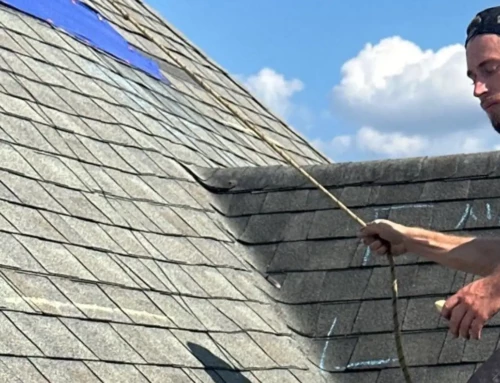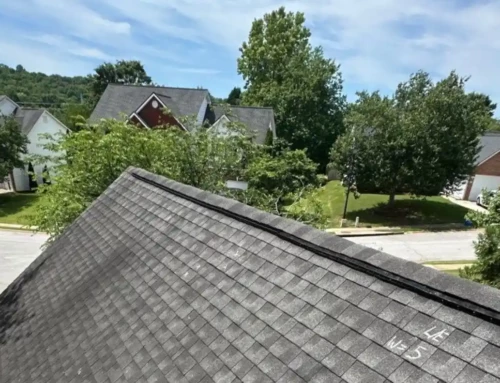Hip Roof vs. Gable Roof
If you are building your new home or designing a new roof style, there comes a time when you need to consider what type of residential roof you want. The most popular roof styles are hip roofs and gable roofs. Although gable roof is the most common roof type in the United States, you will see plenty of hip roofs around.
Both roof types look great and protect your home from the elements, and both types of roofs are popular. Each type has pros and cons, though, so it comes down to the details when you’re trying to choose the one that better fits your expectations and overall home look.
Our hip roof vs gable roof detailed guide will help you make an informed choice. Let’s start with the basics and then let’s move on to compare the most common types so we can help you decide what you want and need for your home.
| Feature | Hip Roof | Gable Roof |
|---|---|---|
| Structure | Slopes on all four sides, converging at the top. | Two sloping sides that meet at a central ridge, forming a triangular shape. |
| Aesthetic Appeal | Symmetrical, elegant, and classic look. | Prominent, angular, adaptable to various architectural styles. |
| Snow Resistance | Good for distributing snow load across all sides. | Better for shedding snow quickly due to steeper slopes. |
| Wind Resistance | Superior wind resistance due to inward slopes. | More vulnerable to wind damage, especially at the gable ends, but can be mitigated with proper construction. |
| Attic Space | Less attic space and headroom due to inward slopes. | More attic space and headroom, suitable for storage or additional living areas. |
| Cost | More expensive to construct due to complex design and additional materials. | Generally more cost-effective and easier to build. |
| Ease of Construction | More complex and time-consuming to build. | Easier and quicker to construct with a simpler design. |
| Opportunities for Decoration | Fewer opportunities due to all sides being sloped, but dormers can be added. | More opportunities for decoration with windows, vents, and trusses on gable ends. |
| Ventilation | Good ventilation possible with ridge and soffit vents. | Easier to achieve ventilation, especially with gable vents, ridge vents, and soffit vents. |
| Climate Suitability | Best for high-wind regions due to stability. | Ideal for regions with heavy snowfall due to snow-shedding capability. |
What Is a Hip Roof?
A hip roof, also known as a hipped roof, features slopes on all four sides of the structure. Think of a church steeple; that’s one type of hip roof.
In hipped roofs, all four sides converge at the top to form a ridge. Each hip roof section has an equal length and slope, though variations exist where the slopes can be of different lengths. This design looks like a pyramid shape for a square structure, or a shape that’s more like a tent for a rectangular structure.
Hip roofs are known for being aesthetically pleasing, but it is the inward slope of all roof sides that makes these types of hip roofs particularly stable and resilient to high wind and heavy snow. This makes them a great choice in areas that witness such weather events.
Hip roofs come in many variations that let them adjust to the overall design of your home. Here are some of the most common ones.
Simple Hip Roof
This is the most basic residential roofing form, with all four sides of equal length and sloping inward to form a ridge at the top. It’s often seen on rectangular structures, making them look clean and symmetrical.
Pyramid Hip Roof
Also known as a square hip roof, this pyramid roof design has four triangular-shaped sides that meet on a single peak at the top. These roofs are typically seen on square buildings.
Cross Hip Roof
This type of hip roof features two hip roof sections that intersect at right angles. They form a cross shape when viewed from above. It’s often used on home roof designs with a more complex layout.
Half-Hip Roof
A half-hipped roof, also known as jerkin head roof, is a combination of a gable and hip roof. The gable ends are truncated by the hips for better wind performance and a more compact structure.
Dutch Gable Hip Roof
A hybrid of a gable and hip roof, this roof has a small gable section at the top of the hip roof for additional attic space and natural light.
What Is a Gable Roof?
A gable roof, also known as a pitched or peaked roof, has two sloping sides that meet at a central ridge, forming a triangular end known as a gable.
The simplicity of the gable roof design allows for easy construction and efficient shedding of water and snow. The roof-sided slope can be of equal or varying lengths to create different and aesthetically pleasing styles.
The vertical triangular wall section at the end of the ridge is called the gable and can be covered or left open for ventilation, depending on the design and other home requirements. Gable roofs are widely used for their straightforward design and cost-effectiveness.
As with the hip roofs, there are many types of gable roofs. Here are some common ones.
Open Gable Roof
This is the most common type, with two triangle-shaped slopes that meet at a ridge while the gable ends are left open. This design is often used in traditional and colonial homes.
Box Gable Roof
This is similar to the open gable, but the triangular sections at the ends are enclosed, creating a more finished look. This type protects better against the elements.
Cross-Gable Roof
Cross gable roof features two gable roof sections intersecting at right angles to form a cross shape. It’s commonly used in Tudor and Cape Cod-style homes.
Front Gable Roof
Often seen in colonial-style homes, this roof has the gable end facing the front of the house, for a distinct facade.
Dutch Gable Roof
A combination of a gable and hip roof, where a gable is placed on top of a hip roof for visual interest and extra attic space.
Saltbox Roof
This type of gable roof has one slope longer than the other to create an asymmetrical design. It’s often used in traditional New England-style homes.
It’s now time to compare the roofs so you can see which one better fits your needs.
Hip roofs vs gable roofs: the Comparison
When you must choose between hip and gable roofs, consider both hip roof advantages and hip roof disadvantages as well as gable roof advantages and gable roof disadvantages.
Snow
If your area witnesses heavy snow in winter, you need to adjust your roof to the weather conditions around your home.
Hip roofs do well in snowy climates because their sides slope downward on all four edges, thus distributing the weight of the snow across a much larger area.
Gable roofs are often doing better in snow because the slope is steeper and it’s easier for snow to slide off quickly so it doesn’t accumulate.
If you have mild snow events in winter, then a hip roof will do perfectly fine. If your area experienced heavy snow, a gable roof might be better.
However, in both cases, you need regular roof inspections and roof repairs to maintain the integrity of your roof during these conditions.
Wind
Hip roofs have much better wind resistance compared to gable roofs. The sides’ slope reduces the surface area exposed to wind and makes it harder for strong gusts to uplift the roof. If your area is exposed to hurricanes and high winds, a hip roof may thus be a better choice.
Gable roofs can be more vulnerable to wind damage, particularly at the gable ends where wind pressure can create uplift forces. Thankfully, there are ways to mitigate this problem with proper construction and bracing to strengthen the roof.
Attic Space
Hip roofs offer less attic space due to their inward-sloping sides. The design can limit headroom and usable storage or living space within the attic. However, variations like the Dutch gable hip roof can provide more space and natural light.
Gable roofs provide more attic space and headroom. This makes them ideal for storage or for converting your attic into additional living areas like an office or playroom. The straightforward triangular design of gable roofs creates a spacious and functional attic environment.
Cost
Hip roofs tend to be more expensive to construct because of their complex design. They also require more materials and labor. The additional framing, eaves, and trusses needed to support the four sloping sides contribute to the higher cost.
Gable roofs are generally more cost-effective and easier to build. The simpler design requires fewer roofing materials and less labor, which results in a less costly construction. If you are looking for a budget-friendly style of roof, a gable roof may be the better choice.
Ease of Building
The construction of hip roofs is more complex as it requires skilled labor and precise framing. The need to create slopes on all sides and deliver structural integrity adds to the construction time and complexity.
Gable roofs are easier and quicker to build because their design is simpler. However, if you want to build better bracing for wind protection, construction gets more complicated.
Looks
Hip roofs look symmetrical and elegant, which makes them visually appealing and adds to the home’s curb appeal. They have a classic look that adds charm and a timeless look to your home.
Gable roofs have a more prominent, angular look with their triangular profiles. They are more adaptable to architectural styles, from colonial to contemporary, and can create a striking and dynamic appearance.
Opportunities for External Decoration
Because all four sides are taken by the slopes, there are fewer opportunities for decorative elements with hip roofs. You can install dormers to add character and additional light to the upper floors.
Gable roofs can be combined with more decorative opportunities such as the inclusion of windows or vents in the gable ends, as well as trusses and brackets that add character to your home and give it a personalized touch.
Ventilation
Did you know that good ventilation can extend the lifespan of your roof?
Hip roofs can deliver good ventilation, thanks to their multiple sloping sides that allow for ridge vents, soffit vents, and even the installation of additional roof vents.
However, gable roofs are slightly more practical for ventilation purposes, offering several ventilation options — especially with gable vents placed on the vertical ends of the roof. These vents can improve airflow and reduce heat and moisture accumulation in the attic. Ridge vents and soffit vents offer even better ventilation. Additionally, it’s easier to install ventilation systems on gable roofs because of their straightforward design.
Hip vs. Gable Roof: Which One Is Best for You?
Ultimately, the choice comes down to not one but several important factors: climate, budget, energy efficiency, attic space requirements, construction complexity, and aesthetic preferences.
Climate assessment
If you live in areas with heavy snowfall, gables might be better due to their snow-shedding features. Conversely, in high-wind regions, a hip roof offers superior wind resistance and stability.
Budget
Budget-conscious homeowners may lean toward a gable roof because it’s cost-effective and easier to construct.
Attic space and ventilation
If you need to use your attic space as part of your home, gable roofs provide more attic space. You can easily turn the space into an office, gym, kids’ play area, or guest room. Ventilation is also more straightforward in gable roofs, although hip roofs can also accommodate ventilation systems with the right design.
Advanced Roofing and Remodeling: the Roofers You Can Trust
If you are still undecided about the type of roof that best fits your home, our roofers at Advanced Roofing and Remodeling will be happy to explain the advantages and disadvantages of each type. Our expert roofing contractor team has the skill to install the most complex roof design and suggest which roof best matches your home, roof structure, and budget.
Do you need a roof replacement? Contact us today for a free roof inspection in our service areas and take advantage of our experience for professional roof and home advice!












